Abstract
The present article presents a description of the leadership labor market in Republic of Moldova, and aims at revealing the characteristics of the hierarchical growth of the current top management from the largest and best-known companies across the country. Understanding and adjusting the behavior and the structure of the leadership labor market would contribute to the development of the companies, and hence to the national economy itself. This article comprises the analysis of the biographical data of top employees hired at the largest and best-known companies from Moldova. The data have been collected over a period of 3 years, by means of face-to-face interviews, as well as internet resources. Per total, there have been gathered data on the employees of 249 companies, namely 340 people from top-management positions (administrators, managers and executives). The results of the study show there is a significant share of people which have a nontraditional model of career growth, achieving leading positions straight from the junior level. This fact influences the behavior of entrepreneurs on the market, as well as the overall economic results of the country.
Key words: leadership labor market, Republic of Moldova, models of hierarchical growth.
Introduction
The labor force at managerial level represents an important engine of the economy of each country, as well as of the world economy overall. The human resource is currently being shaped as the most valuable asset of a territory, of a geographical space etc., particularly during the era of globalization, during the 4th revolution in the history of the civilization - the technological one. Being the only asset with depository capacity, it carries in itself the most important principle of development - innovation, without which competitiveness today is inconceivable. Furthermore, this resource is being transformed into the main vector of innovation's diffusion over a broad territory, which is most advanced structurally and functionally.1
An evaluation of the characteristics and of the potential of this labor force segment allows identifying the driving forces of the economy and facilitates employers' choice of suitable people in managing positions.
In the case of Moldova, the major impediment for the recruitment of qualified personnel is the lack of a recruiting management system, as well as the migration abroad of talented staff.
Economically talking, the central role of migration is evidenced by the fact that almost 20% of the active population works abroad the country, particularly as the revenues transferred by these migrant workers during the 2005 year were equivalent to 30% of the GDP. According to the share in the GDP of the revenues transferred by the citizens working abroad, Moldova is ranked second in the world.2
In these circumstances, the external mobility (employees' frequency of changing hiring companies) becomes an important mechanism for the reallocation of managerial resources suitable for the large and medium-sized companies in Republic of Moldova, companies which are significantly fewer in number if compared to the small and micro-sized ones.
Analysis of the external mobility of managerial employees allows creating the profiles of top employees by types of companies, thus contributing to the possibility of selecting the best candidates for the leading positions.
At the same time, lack of researches in the field of human resource' management in Republic of Moldova, studies which would reveal the models of hierarchical growth, the characteristics of the emergent top-management, as well as their comparison with the developed markets, represents a barrier to the development of the inland economy (through the reorganization of existing companies).
Considering these global phenomena, University of St. Gallen in Switzerland has initiated an international project in Switzerland, Albania, Romania and Moldova. Within the project "Empirical study of the leadership labor force in the Republic of Moldova", initiated by the University of St. Gallen and accomplished by the Institute for Public Policy and Magenta Consulting, an assessment of the top-management employed at the largest and best-known companies in Moldova was made.
The study reveals the behavioral characteristics with regards to the hierarchical growth of managerial employees currently hired at the largest and best-known companies in the country.
An overview on these inter-dependencies, as well as a deeper understanding of the behavior of management staff, would allow HR managers and business owners to establish strategies for attracting and keeping staff at this hierarchical level, and also would allow them to forecast the behavior of their employees.
Besides presenting general behavioral models, the study also analyzes the inter-dependency of these models with demographic factors or structures of companies, providing a broader view over the researched topics.
The article is structured as follows: first of all are analyzed data regarding the carrier growth, number of companies for which the employee has worked and the demographic data or structure of the company. Following, are formulated hypotheses based on the correlations of the mentioned indicators (age or sex of respondent and number of companies in which s/he was hired, model of career growth). Below are presented the data and the methods used within the study, followed by a presentation of the data. Finally, the conclusions and the applications of the research are put forward.
Theories and Hypotheses
The labor market is characterized by two forms of employees' mobility: internal (within the same company) and external (between different companies).
According to Andreea Rus, in her paper "French labor market" within the project "New methods of analysis and diagnosis of the labor market" was mentioned that in terms of mobility there are differences based on the size of the enterprise, area of activity or features of the labor provider. Mobility of employees records higher values in small and medium-sized companies. At the same time, internal mobility reaches lower levels in small companies, while in larger ones it is significantly higher. In conclusion could be stated, similarly to what T. Amosse mentioned (2003), that large businesses have established dynamic internal markets (existence of protected mobility, attracts employees by offering them job security and career growth perspectives). Additionally could be concluded that employees of small-sized businesses are trying to fight against a precarious workplace, searching for a job in large companies. Once they achieve their objective, they try to stabilize their position and even improve it. These statements are backed by the high rates of external mobility: in small enterprises the employment-unemployment rate is increased, while in large companies the values of this indicator is much lower.3Worth noting is the fact that these findings are applicable for the employees of all levels, particularly in France. Therefore, the objective to confirm or invalidate these phenomena for the top employees of Republic of Moldova was established.
Hypothesis 1: The first hypothesis assumes the existence of an inter-dependence between the sex of the top manager and the length of employment in a company.
Thus, it is assumed that women tend to stay in a company longer than men do. This assumption is based on particular social, as well as psychological aspects. Among the social aspects was referred to the period of maternity, which leads to the detention of women in particular positions longer periods of time. Although it might be considered that because women don't represent the main source of income for the family, they have the option to change their job without worrying about the impact on the family income; however, due to the economy in transition, women' income tends to constitute a rather significant share in the total revenues. Viewing the issue under a different aspect, it may be stated that because women are permanently in search of stability, they are less likely to risk by changing jobs.
Hypothesis 2: The second hypothesis is related to the fact that in large companies the career growth is more difficult and follows a traditional pattern (employee - top-manager - board).
Considering the great number of employees in large companies it takes considerable competitive effort to grow hierarchically. At the same time, large-sized companies comprise several levels, which suppose that the employee has to get through many more professional stages. It is to note the fact that in small companies, employees with managerial abilities are noticed much easier, which makes their ascent faster, without having to pass through all the formative levels.
Data and Methods
For the purposes of the research "Empirical study of the leadership labor force in the Republic of Moldova", the biographical data of top employees from largest and best-known Moldavian companies have been collected, over a period of 3 years, either via face-to-face interviews or from internet. During the first stage of the research, a sample of 400 enterprises was selected, distributed representatively via all fields of activity, according to the National Classification of Business Activities in Republic of Moldova. The top of most known companies was determined based on the previous researches of Magenta Consulting, during which people indicated 3 most known companies per field of activity. At this stage, a total of 190 CVs were collected. Given the absence of a national database with data about the board members of each company, the CVs have mainly been collected via face-to-face interviews. In most cases, only one CV was possible to be filled in per company, in majority of cases this belonging either to the general director or to the executive director of the enterprise. A considerable obstacle in the collection of CVs constituted the lack of statistical data, as well as respondents' lack of receptivity, the main argument being their fear of losing valuable employees.
During the second stage of the project, in order to ensure comparability of data collected at international level, Magenta Consulting resorted to the data bank of the National Bureau of Statistics, which offered information on the top 150 companies from Republic of Moldova. Of these 150 companies, 27 were excluded from the list, given the fact that these are state enterprises (the decisions and actions of which are influenced by the state policies). At this stage a total of 45 CVs were gathered. In order to increase the volume of collected data, it was decided in favor of extending the list of companies up to 400. Thus, to the database of companies, other 31 legal entities have been added.
Finally, data on 249 companies were obtained, the information being collected on 340 employees: administrators, managers and executives. The distribution of people according to executive and non-executive positions is of 95% to 5%, the second group includes and people without power of decision, but on leading positions, and employees which don't hold executive positions, but have power of decision (business owners).
Variables
Dependent variables
The dependent variables used within the study are: type of career, number of companies for which the employee worked, average length of years worked at a company, number of years worked in total, number of foreign companies for which the respondent worked.
Independent variables
The independent variables used within the analysis are: employee's age and sex.
Control variables
The control variable used within the study was the size of the company: large-sized companies 250+ employees, medium-sized companies - 50-249 employees, small-sized ones - 10-49 employees and micro enterprises - up to 10 employees.
Data analysis
Data were initially codified, then analyzed with the help of the statistical soft SPSS 18. It is to note the fact that for the analysis of the career growth model, patterns of hierarchical growth were created, being codified for each individual interviewed, and then analyzed.
Thus, the scale data (length in years spent at a company) were analyzed in correlation to the dependent variables: age, sex. Following, the ordinal variable - model of growth was analyzed in correlation to the dependent variables. In process of data analysis, the above mentioned hypotheses were tested, and the results are described below.
Results
The analysis of the data revealed that from the demographic perspective, among top employees are encountered more men (73%). This distribution can be influenced by a range of factors, among which - historical status of women in society and in the economic life, the maternity period, as well as other factors.
Most representatives from the analyzed segment are aged between 30 to 40 years, this being the age of self-accomplishments, the period for maximal fructification of abilities, during which are ended several levels of education, and sometimes the period during which a family is being constituted, fact which ensures stability and possibility for career growth.
In order to identify the model for career growth, data were collected regarding the length of periods people spend in position of regular employees, then in top management, followed by board positions. On average, the longest length of activity of employees with power of decision within companies, is particularly when they hold positions in the board (7.3 years). Most often, employees have a quick ascent towards leading positions, the lowest period of time people tend to hold top-management jobs. This can be explained by the fact that while in top-management, people are fully able to demonstrate their abilities of administrators and are able to get distinguished among their colleagues, thus advancing towards board positions.
Figure 1: Average number of years spent by the actual top managers at different hierarchical levels in company, N=339, years
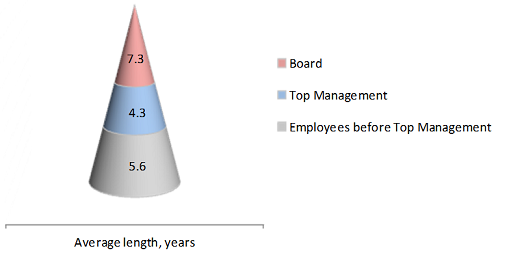
Analyzing respondents' length of activity at a certain level, it was possible to create a map describing the model of career growth, which graphically corresponds to the following scheme:
Figure 2: Type of career growth models, N=339
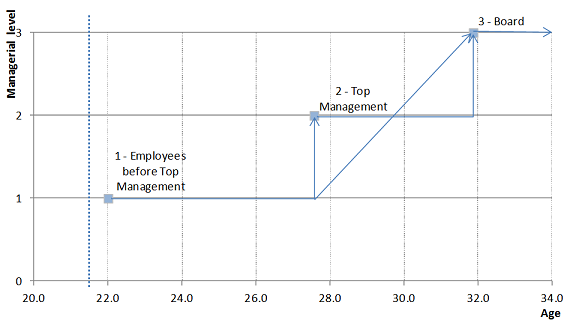
The analysis of the data made it possible to group the respondents in 7 distinct groups, according to their model of career growth. Thus, the distribution per models of growth can be visualized in the table below:
Table 1: Distribution of top managers according to the types of career growth models, N=339, %,
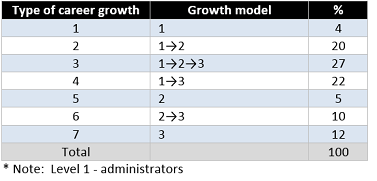
As one can notice, the traditional model of career ascent - from employee to top management, then to board positions, is the most frequently encountered one. However, it should be pointed on the share of employees which have ascended from the junior level straight to the board (22%), as well as the share of those hired directly on board positions (12%). The last percentage can be explained by the fact that in some cases, people decide to start up a business immediately after graduating the university, or in case of family businesses, children take over board positions in parents' companies straight from university years.
Analyzing the number of companies in which activated top managers, it was determined that this number ranges from 1 to 11, most being hired in 2-4 companies. The average length of employment within a company is of 4.89 years. After testing the first hypothesis - the inter-dependence between the number of years spent in a company and employees' gender, it was determined there is no such a dependency (R=0.11, sig.=0.839). Therefore the first hypothesis is not supported by the data.
As well, there is no inter-dependence between the average length of years of employment of top management and the size of the companies at which they are hired (R=-0.57, sig.=0.295). However, it was determined there is a significant correlation between the average length of employment at a company and the model of hierarchical growth, which is directly proportional, meaning that people who go through several steps of the hierarchical ladder, for them it's characteristic to have on average a reduced period of activity within a company (R=0.319, sig.=0.000). Similarly, positive correlation was determined also for the entire career activity. It was proved that people with greater work experience are more stable at their workplace (R=0.518, sig.=0.000), this might be conditioned by the evolution of things during Soviet Union times. Another conclusion for the found data indicates on the fact that the new generation is more hectic along their professional life. An inversely proportional relationship, rather significant, was determined for the average length of years worked in a company and the total number of companies at which the person was hired (R=-0.395, sig.=0.000).
Considering the number of companies at which were employed the respondents, it was possible to determine that the most fruitful career ascent is taking place if switching 2-3 companies. Switching the workplace in 4 and more companies brings less significant growth in career.
Table 2: Distribution of top managers based on the types of career growth models and number of companies for which they were, N=339, %
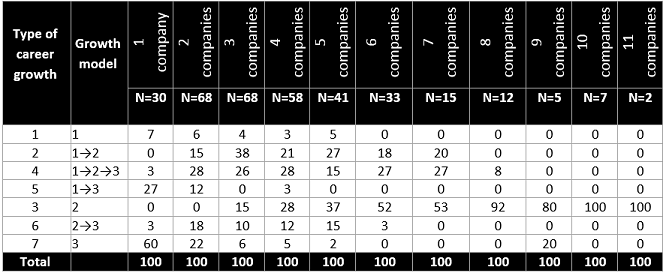
The statistical testing of the data indicates that the model of career ascent is dependent upon the size of the company in which the person is employed, the link between them being inversely proportional. Thus, for the top managers from medium and large-sized companies the ascent is more difficult than for the managers from micro and small-sized enterprises (R=-0.215, sig.=0.000). This is also conditioned by the number of candidates applying for the leading position, as well as by the range of criteria required for getting the job. Therefore, the second hypothesis was confirmed.
Table 3: Distribution of top managers based on the model of career growth and size of company at which is hired, N=339, %
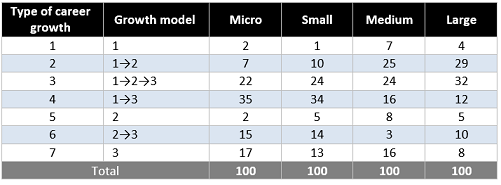
As result of the study it was concluded that women have a stormier ascent on the hierarchical career growth, however in many more cases they are the ones who remain blocked at the middle level of the career. The last affirmation was also confirmed statistically (R=-0.263, sig.=0.000). Thus, the distribution of models for career growth according to the sex of respondent is presented in the figure below:
Figure 3: Distribution of top managers based on models of career growth and on sex, %
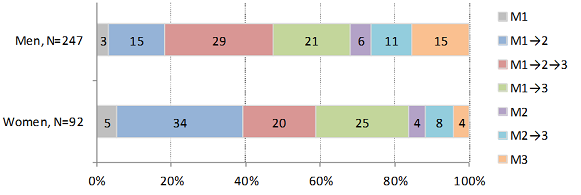
Another fact statistically confirmed is that for large-sized companies is more characteristic to hire people with experience in foreign companies (R=0.160, sig.=0.003).
A positive correlation was found between the size of the company and the number of companies at which the employee was hired (R=0.134, sig.=0.14). Thus, in large companies, in top management are hired people which switched a greater number of companies, fact confirmed by the hypothesis. The stability characterizing small companies is explained particularly by company's internal environment, and namely that employees of small enterprises are related not only by professional ties, but also by personal ones. This fact comes in contradiction with the theory of T. Amosse (2003), described at the beginning of this chapter, the fact that large enterprises have instituted dynamic internal markets (existence of this protected mobility, attracts employees by offering them job security and career growth perspectives). However, this can find explanation in the characteristics of the segment analyzed - top management, segment which has rather particular behavior.
Conclusions and applications of the research
In result of the data analysis, it was possible to ascertain that among the top employees in Republic of Moldova, there are more men than women. However, when correlating the average length of activity within a company and employees' sex, it was statistically proved that these two variables are not inter-dependent. Considering the age of top managers, it was possible to affirm that young people have on average a shorter length of employment within an enterprise. With the above displayed data, it was possible to determine the profiles of 2 categories of employees: first are those who have a more toilsome career ascent, however rather firm, passing through all hierarchical levels of professional growth and having on average a longer period of employment within a company, and the second group is represented by those with a more stormy growth, passing over certain levels and having on average a shorter employment period (particularly the younger people). The most fruitful career ascents take place while switching from 2 to 3 employers. Employment in 3 and more companies does bring professional ascent, however not that considerable.
At the same time, the top managers currently employed at large and medium-sized companies follow a traditional pattern of ascent, which is more difficult, if compared to the top managers of the micro and small-sized entities. Top employees of large companies are characterized by a greater experience in foreign enterprises, as well as by a greater number of companies-employers.
Generating these conclusions characteristic for the managerial employees of Republic of Moldova contributes to the creation of top employees' profiles, thus it facilitates the establishment of a general image for the desired staff. This article aims at creating the theoretical support for the HR employees, for the executives, and for the employees themselves who want to achieve career growth and who want to attain particular professional objectives.
Being one of the few existing studies at national level regarding the behavior and characteristics of employees, and being the sole research focusing on the managerial employees evaluation, it constitutes a basis for the formulation of individual strategies for natural persons - as employees, for legal entities - as employers or recruiting companies, as well as various state institutions - in formulating strategies for the development of economy, by shaping it at the level of the existing companies.
The development of similar extensive studies, the establishment of public databases with reference to the biography of employees from top management, would all significantly contribute to the extension of the created profiles, and implicitly would contribute to the creation of well-defined strategies at company level, as well as at level of national policy of maintaining qualified staff within the country.
Authors:
Slonovschi Dumitru - Doctorand, Director general Magenta Consulting
Casap Lucia - Cercetător principal Magenta Consulting
Gremalschi Anatol - Doctor habilitat, Profesor universitar, Director de programe la Institutul de Politici Publice
The study was funded by the Swiss Foundation for Science